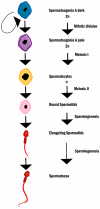The Role of ROS as a Double-Edged Sword in (In)Fertility: The Impact of Cancer Treatment
- PMID: 35326736
- PMCID: PMC8946252
- DOI: 10.3390/cancers14061585
The Role of ROS as a Double-Edged Sword in (In)Fertility: The Impact of Cancer Treatment
Abstract
Tumor cells are highly resistant to oxidative stress resulting from the imbalance between high reactive oxygen species (ROS) production and insufficient antioxidant defenses. However, when intracellular levels of ROS rise beyond a certain threshold, largely above cancer cells' capacity to reduce it, they may ultimately lead to apoptosis or necrosis. This is, in fact, one of the molecular mechanisms of anticancer drugs, as most chemotherapeutic treatments alter redox homeostasis by further elevation of intracellular ROS levels or inhibition of antioxidant pathways. In traditional chemotherapy, it is widely accepted that most therapeutic effects are due to ROS-mediated cell damage, but in targeted therapies, ROS-mediated effects are mostly unknown and data are still emerging. The increasing effectiveness of anticancer treatments has raised new challenges, especially in the field of reproduction. With cancer patients' life expectancy increasing, many aiming to become parents will be confronted with the adverse effects of treatments. Consequently, concerns about the impact of anticancer therapies on reproductive capacity are of particular interest. In this review, we begin with a short introduction on anticancer therapies, then address ROS physiological/pathophysiological roles in both male and female reproductive systems, and finish with ROS-mediated adverse effects of anticancer treatments in reproduction.
Keywords: (in)fertility; chemotherapy; oxidative stress; reactive oxygen species (ROS); targeted agents.
Conflict of interest statement
We here state that the material contained in the submitted manuscript has not been published previously, and has not being submitted elsewhere for publication. We declare that we all participated in the present study and that we have seen and approved the final version. We also declare that if this publication is accepted, it will not be published elsewhere including electronically in the same form, in English or in any other language, without the written consent of the copyright-holder. There was also no Fabrication, falsification, plagiarism, repetitive publications, obfuscation, no human research or experimentation. All authors also agree the order of authorship. All Authors disclose any actual or potential conflict of interest including any financial, personal or other relationships with other people or organizations within three years of beginning the submitted work that could inappropriately influence, or be perceived to influence their work, such as manufacturers of pharmaceuticals, laboratory supplies, and/or medical devices. It also includes employment, consultancies, stock ownership, honoraria, paid expert testimony, patent applications/registrations, and grants or other funding, including any financial arrangement with a company whose product is prominent in the submitted manuscript or with a company making a competing product, and any commercial affiliations.
Figures





Similar articles
-
Influence of reactive oxygen species on human sperm functions and fertilizing capacity including therapeutical approaches.Arch Gynecol Obstet. 2013 Jul;288(1):191-9. doi: 10.1007/s00404-013-2801-4. Epub 2013 Mar 30. Arch Gynecol Obstet. 2013. PMID: 23543240 Review.
-
Design and discovery of novel quinazolinedione-based redox modulators as therapies for pancreatic cancer.Biochim Biophys Acta. 2014 Jan;1840(1):332-43. doi: 10.1016/j.bbagen.2013.08.005. Epub 2013 Aug 15. Biochim Biophys Acta. 2014. PMID: 23954204
-
Reactive oxygen species (ROS): utilizing injectable antioxidative hydrogels and ROS-producing therapies to manage the double-edged sword.J Mater Chem B. 2021 Aug 28;9(32):6326-6346. doi: 10.1039/d1tb00728a. Epub 2021 Jul 25. J Mater Chem B. 2021. PMID: 34304256 Review.
-
The role of cellular reactive oxygen species in cancer chemotherapy.J Exp Clin Cancer Res. 2018 Nov 1;37(1):266. doi: 10.1186/s13046-018-0909-x. J Exp Clin Cancer Res. 2018. PMID: 30382874 Free PMC article. Review.
-
A novel and compact review on the role of oxidative stress in female reproduction.Reprod Biol Endocrinol. 2018 Aug 20;16(1):80. doi: 10.1186/s12958-018-0391-5. Reprod Biol Endocrinol. 2018. PMID: 30126412 Free PMC article. Review.
Cited by
-
Cratoxylum formosum ssp. pruniflorum induces gastric cancer cell apoptosis and pyroptosis through the elevation of ROS and cell cycle arrest.Cell Biochem Biophys. 2024 Sep;82(3):2937-2955. doi: 10.1007/s12013-024-01408-4. Epub 2024 Jul 19. Cell Biochem Biophys. 2024. PMID: 39028496
-
Euphorbiasteroid Induces Apoptosis as Well as Autophagy through Modulating SHP-1/STAT3 Pathway in Hepatocellular Carcinoma Cells.Int J Mol Sci. 2023 Sep 5;24(18):13713. doi: 10.3390/ijms241813713. Int J Mol Sci. 2023. PMID: 37762016 Free PMC article.
-
Metal-organic framework-encapsulated dihydroartemisinin nanoparticles induces apoptotic cell death in ovarian cancer by blocking ROMO1-mediated ROS production.J Nanobiotechnology. 2023 Jun 29;21(1):204. doi: 10.1186/s12951-023-01959-3. J Nanobiotechnology. 2023. PMID: 37386404 Free PMC article.
-
Vitamins, Coenzyme Q10, and Antioxidant Strategies to Improve Oocyte Quality in Women with Gynecological Cancers: A Comprehensive Review.Antioxidants (Basel). 2024 Dec 19;13(12):1567. doi: 10.3390/antiox13121567. Antioxidants (Basel). 2024. PMID: 39765895 Free PMC article. Review.
-
A β-glucosidase extracted from walnut (Juglans regia L.) green husk induces human hepatoma cell apoptosis via ROS-mediated p53 and NF-κB pathway.Food Sci Biotechnol. 2025 May 10;34(11):2581-2589. doi: 10.1007/s10068-025-01890-3. eCollection 2025 Jul. Food Sci Biotechnol. 2025. PMID: 40492030
References
-
- Panji M., Behmard V., Zare Z., Malekpour M., Nejadbiglari H., Yavari S., Nayerpour T., Safaeian A., Maleki N., Abbasi M., et al. Suppressing effects of green tea extract and Epigallocatechin-3-gallate (EGCG) on TGF-β- induced Epitheli-al-to-mesenchymal transition via ROS/Smad signaling in human cervical cancer cells. Gene. 2021;794:145774. doi: 10.1016/j.gene.2021.145774. - DOI - PubMed
-
- Piktel E., Ościłowska I., Suprewicz Ł., Depciuch J., Marcińczyk N., Chabielska E., Wolak P., Wollny T., Janion M., Parlinska-Wojtan M., et al. ROS-Mediated Apoptosis and Autophagy in Ovarian Cancer Cells Treated with Peanut-Shaped Gold Nano-particles. Int. J. Nanomed. 2021;16:1993–2011. doi: 10.2147/IJN.S277014. - DOI - PMC - PubMed
Publication types
LinkOut - more resources
Full Text Sources

